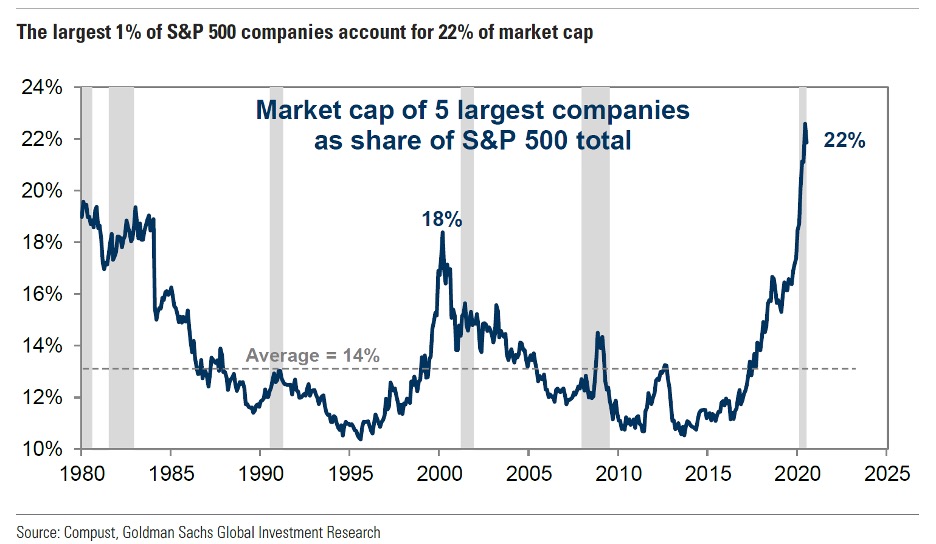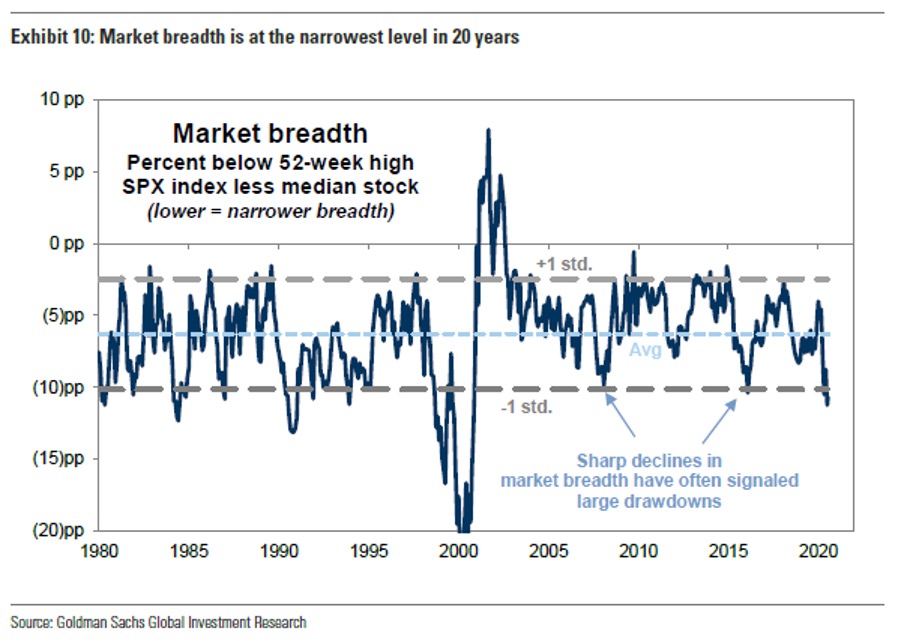I’m getting a lot of questions that are a variation of one major question: “Do you own FAANG/FAAMG stocks?”
My answer? No—well at least not individually.
Here’s one reason why…
Concentration. The FAAMG stock concentration (Facebook (FB), Amazon (AMZN), Apple (APPL), Microsoft (MSFT), and Google (GOOGL)) in the U.S. equity market has been rising all year. They are now the five largest U.S. stocks and now account for 22% of total S&P 500 market cap.
Yeah, 22%.
That’s up from 19% in January 2020 and up from 16% a year ago. These five stocks have a combined weight equal to the combined weight of stocks 142 through 500 in the S&P 500.
But wait, there’s more…
These stocks have increased 35% year-to-date and each of them set a new record high…this month!
What about the other 495 stocks in the S&P 500? According to Goldman Sachs’ David Kostin, those 495 stocks have a -5% year-to-date return.
Need a visual? Don’t worry, we’ve got you covered… (Thanks, David Kostin & Goldman.)


No wonder everyone is out buying these stocks and then acting like people who don’t own them are crazy and missing the boat.
I’m not going to invoke a comparison to 2000…these stocks actually have excellent profit margins and strong balance sheets. But the problem is that these stocks present a huge risk TO THE INDEX.
Kostin goes on to cite an example: “…if the FAAMG stocks declined by 10%, in order to keep the market trading flat the bottom 100 S&P 500 stocks would have to rise by a collective 90%.”
So, one of two things will happen – either these stocks get hammered down to fall in line with the rest of the market, OR, the rest of the market catches up.
The term “market breadth” reflects this. A narrow market breadth means only a few stocks are leading the index higher. In the past, narrow market breadth has usually taken place before a sell-off.
What does market breadth look like now? It’s the narrowest it has been in the past 20 years.

If you are a regular reader of this blog, you know that I’d never advocate using this or anything else as a market timing tool…narrow market breadth can exist a long time before a downturn materializes.
I’m saying BE CAREFUL.
And I’m saying that if you are an indexer and heavily exposed to an S&P 500 ETF (say through your TSP), you need to understand that you have MASSIVE exposure to these five stocks and you’d be wise not to add to that exposure in other accounts.
Moderation is important, and it’s the opposite of concentration. Have moderation.
Finally – remember our old ‘fr-enemy’ loss aversion…any losses you experience will hurt twice as much as any joy you felt from the gains. You can get where you want to go with an investment strategy that does not include massive exposure to these five securities.
Oh, and call us if that sounds good to you.
And for you clients out there in our Core ETF Strategy, don’t worry…you own APPROPRIATE/MODERATE exposure to these FAAMG stocks through ETFs, which is another reason we don’t own them directly in our other strategies.
Keep (carefully) looking forward
This first appeared on Monument Wealth Mangement.
Related: The Future of the Economic Recovery Will Be Decided by Another Lockdown – Is One Coming?


